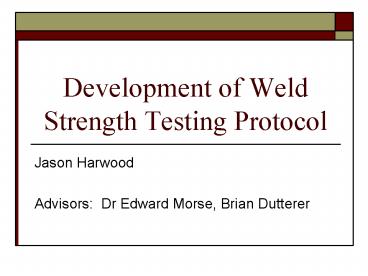Development of Weld Strength Testing Protocol - PowerPoint PPT Presentation
1 / 22
Title:
Development of Weld Strength Testing Protocol
Description:
Design a welding test for the Mechanical Engineering/Motorsports program ... Hardness tester. Radiography. Faculty Welding Experience. Brian Dutterer ... – PowerPoint PPT presentation
Number of Views:221
Avg rating:3.0/5.0
Title: Development of Weld Strength Testing Protocol
1
Development of Weld Strength Testing Protocol
- Jason Harwood
- Advisors Dr Edward Morse, Brian Dutterer
2
Project Overview
- Design a welding test for the Mechanical
Engineering/Motorsports program - Allow for evaluation of student welding abilities
- Visual inspection of welds
- Strength testing
- Based on existing national standards
3
Basic Welding Gas
- Oxyacetylene Welding
- Heat comes from burning oxygen and acetylene
- Requires two gas tanks, torch
- Requires separate filler material to be added
4
Basic Welding Electric
- MIG (Metal Inert Gas) welding
- Electrical arc forms between work and electrode
- Filler metal is fed in as a wire
- Shielding comes from coating on wire
Image courtesy www.earlbeck.com/Training20Catal
og.htm
5
Basic Welding Electric
- TIG (Tungsten Inert Gas) welding
- Electrical arc again provides heat
- Tungsten electrode is not consumed
- Shielding comes from argon gas blowing past
tungsten
6
Why Welding?
- Welds can be as strong, or stronger than original
material - Requires no extra fixtures for components
- Very flexible in position and joint styles
7
UNCC Motorsports Welding Uses
- Vehicle construction
- Roll cages and pickup points for Formula SAE,
Baja teams - Vehicle repair/maintenance
- Legends cars bumpers, Formula/Baja chassis
modifications/repairs - Student project assistance
- Helping with design projects, personal projects
8
Step 1 Identifying the Needs
- Identifying needs of the program
- Primarily TIG welds
- Clean, precise welds
- Welder and filler metal readily available in shop
- Steel and aluminum welding both used
- Strong, consistent welds
- Able to withstand chassis flex, cornering loads,
impacts
9
Step 1 Identifying Resources
- Identifying existing welding standards
- ASME welding standards
- School equipment for tests
- Load frame
- Hardness tester
- Radiography
- Faculty Welding Experience
- Brian Dutterer
10
Step 2 Understanding Welding
- Learning to weld
- Began basic TIG welding
- Using metal coupons, with and without filler
metal - Became familiarized with what to look for while
welding
11
Step 3 Establishing Test Criteria
- Evaluations based on ASME Boiler and Pressure
Code, Section IX 1992 Edition - Outlines all welding and brazing standards
- Three most common welds performed by students
- Aluminum (mainly plate)
- Steel plate
- Steel tube
12
Step 3 Establishing Test Criteria
- Tailoring ASME code to UNCCs needs
- Code requires numerous positions and test
- Many uneconomical or not applicable
- Radiography machine resources couldnt be
coordinated during project - Readily available tests
- Tensile strength
- Bending
- Visual inspection
13
Step 4 Tools for Testing
- Build fixture for steel tube welding
- ASME calls for tubing not to be rotated during
test - Simple fixture devised from steel plate, rod and
aluminum rod
14
Step 4 Tools for Testing
- Jig for guided bend test
- Allows for welds to be bent and stretched
- Shows cracks or lack of penetration in weld
15
Step 4 Tools for Testing
- Tensile strength test
- Use load frame on second floor
- Machine weld area to 1/8 in2 area at weld
- Steel should hold 60-70 ksi, weld material rated
to hold 80 - Sample should at least be as strong as original
specifications - Breaks not at the weld, and within 10 of
original material strength, are acceptable
16
Step 5 Finalizing the Test
- Part 1 Steel Plate Test
- Open groove, butt weld two steel coupons, each 5
X 6.5 - Joint style requires gap between coupons, making
weld more difficult than flush plates
17
Step 5 Finalizing the Test
- Part 2 Steel Tube Test
- Weld 360o around 1 O.D., .065 wall thickness,
cold worked steel tube (similar to chassis
tubing) - Piece is cut into 4 pieces, pieces are then
pulled in load frame
18
Step 5 Finalizing the Test
- Part 3 Aluminum Plate Test
- Butt weld Aluminum plate, 1/8 thick, 3000 series
19
Accomplishments
- Learned basic TIG welding
- How welds should look during and after process
- Tweaking machine and heat to get proper heat
- Established basic welding test
- Covers most common materials used in shop
- Test gives quantitative and qualitative results
20
Future Projects/Ideas
- Finish guided bend jig
- Explore radiography testing
- Hardness testing
21
Lessons Learned
- Time Management
- Most tasks take twice as long as expected
- Nothing can take the place of money and materials
- Basic research structure
- Importance of following basic scientific method
22
Acknowledgements
- James Phipps, Will Scotton, and Grant Cameron for
welding tips - Gary Hodgkin for load frame assistance






























